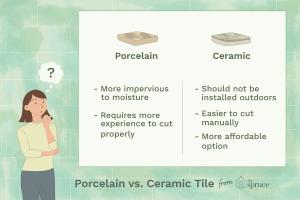Mastering the Art of Tile: How to Distinguish Between Porcelain and Ceramic Tiles

-
Quick Links:
- Introduction
- What Are Ceramic and Porcelain Tiles?
- Key Differences Between Porcelain and Ceramic Tiles
- Durability and Maintenance
- Installation Process
- Design and Aesthetics
- Cost Considerations
- Real-World Case Studies
- Expert Insights
- Step-by-Step Guide: Choosing the Right Tile
- FAQs
Introduction
When it comes to selecting flooring options for your home, the choice between porcelain and ceramic tiles can be daunting. Both materials offer unique benefits and drawbacks, making them popular choices for various applications. This comprehensive guide will explore the differences between porcelain and ceramic tiles, helping you make an informed decision for your next home improvement project.
What Are Ceramic and Porcelain Tiles?
Ceramic tiles are made from a mixture of clay, water, and other natural materials. They are fired at lower temperatures, resulting in a more porous tile that can be glazed for color and design. Porcelain tiles, on the other hand, are made from a denser clay and fired at higher temperatures, creating a more durable and less porous tile.
Composition
- Ceramic Tile: Composed of natural clay, sand, and water.
- Porcelain Tile: Made from refined clay and feldspar, fired at high temperatures.
Types
Both ceramic and porcelain tiles come in various types, including glazed, unglazed, and textured options, each suited for different applications.
Key Differences Between Porcelain and Ceramic Tiles
| Feature | Ceramic Tile | Porcelain Tile |
|---|---|---|
| Durability | Less durable, prone to chipping and cracking | Highly durable, resistant to wear and moisture |
| Porosity | More porous, can absorb water | Less porous, more water-resistant |
| Cost | Generally less expensive | Typically more expensive |
| Applications | Best for low-traffic areas | Ideal for high-traffic areas and outdoor use |
Durability and Maintenance
Porcelain tiles are known for their durability, making them suitable for high-traffic areas and outdoor settings. They are less likely to chip or crack compared to ceramic tiles. Maintenance is straightforward: regular cleaning with mild soap and water is often sufficient. Ceramic tiles, while still durable, require more careful handling to avoid damage.
Installation Process
The installation process for both types of tiles is similar, but the density of porcelain may require special cutting tools. It’s essential to follow the manufacturer's guidelines to ensure a successful installation.
Design and Aesthetics
Both ceramic and porcelain tiles come in a variety of designs, colors, and finishes. Ceramic tiles often have more vibrant colors due to the glazing process, while porcelain tiles may mimic the appearance of natural stone or wood.
Cost Considerations
When budgeting for your tile project, consider both material and installation costs. Ceramic tiles are generally more affordable, but porcelain offers long-term durability that might save money in maintenance and replacement costs.
Real-World Case Studies
Case Study 1: Residential Kitchen Renovation
A homeowner chose porcelain tiles for their kitchen remodel due to its durability and resistance to stains. After two years, the tiles still look pristine, proving to be a worthwhile investment.
Case Study 2: Commercial Space Flooring
A restaurant opted for ceramic tiles in its dining area for cost-effectiveness. However, after several months, they found that the tiles were chipping and needed replacement sooner than expected.
Expert Insights
Experts suggest that the choice between porcelain and ceramic tiles should align with the intended use of the space. For areas with high moisture, such as bathrooms, porcelain is highly recommended. For lower-traffic rooms, ceramic offers a budget-friendly option without sacrificing style.
Step-by-Step Guide: Choosing the Right Tile
- Assess the area where the tiles will be installed.
- Determine the traffic level and moisture exposure.
- Set a budget for both materials and installation.
- Explore design options that fit your aesthetic preferences.
- Consult with a professional for installation advice.
FAQs
1. What is the main difference between porcelain and ceramic tiles?
The main difference lies in their composition and firing temperatures, affecting their durability and porosity.
2. Are porcelain tiles more expensive than ceramic?
Generally, yes. Porcelain tiles are typically more costly due to their durability and manufacturing process.
3. Can porcelain tiles be used outdoors?
Yes, porcelain tiles are suitable for outdoor use due to their low porosity and high durability.
4. How do I maintain my ceramic tiles?
Ceramic tiles can be maintained with regular cleaning using mild soap and water.
5. Is it possible to install porcelain tiles myself?
While DIY installation is possible, it may require specialized tools due to the density of porcelain.
6. What are the best uses for ceramic tiles?
Ceramic tiles are ideal for low-traffic areas, such as bathrooms and decorative walls.
7. How do I know if my tiles are porcelain or ceramic?
Check the packaging or consult with the retailer; porcelain tiles are denser and often labeled as such.
8. Can I use ceramic tiles in a shower?
Yes, but ensure they are glazed to prevent water absorption.
9. What is the lifespan of porcelain tiles?
Porcelain tiles can last 50 years or more if properly maintained.
10. Are there eco-friendly options for ceramic tiles?
Yes, several manufacturers offer eco-friendly ceramic tiles made from recycled materials.
Random Reads
- How to save videos on whatsapp android
- How to save streaming video
- Mastering the art of chopper use in gta online
- How to paint a garage door
- How to paint a mirror
- How to paint a rusty metal shed
- Mastering the art of duel in red dead redemption
- How to make a gravel driveway
- How to make a hidden camera
- How to test temperature sensor multimeter